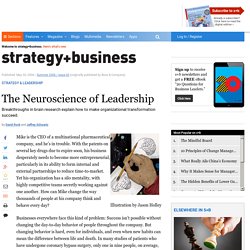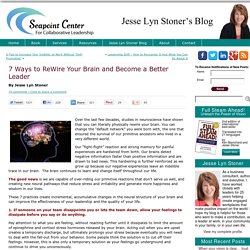

Human brain still active minutes after heart stops beating, new research finds. Neurologists studying the brains of nine patients as they died have found surprising information about what happens to your brain after it dies.

According to the new study, death is marked by a final wave of electrical activity in our brains called “spreading depression.” This “spreading depression” is a final flurry of activity that occurs in the brain before it finally shuts down, according to the experts.
Neuroscience. Executive Functions. The Neuroscience of Leadership. Mike is the CEO of a multinational pharmaceutical company, and he’s in trouble.

With the patents on several key drugs due to expire soon, his business desperately needs to become more entrepreneurial, particularly in its ability to form internal and external partnerships to reduce time-to-market. Yet his organization has a silo mentality, with highly competitive teams secretly working against one another. Managing With The Brain In Mind. Learning about the brain changes everything: David Rock at TEDxTokyo. Beyond Bias. A version of this article appeared in the Autumn 2015 issue of strategy+business.

Illustration by Lincoln Agnew Imagine that you are hiring an employee for a position in which a new perspective would be valuable. But while reviewing resumes, you find yourself drawn to a candidate who is similar in age and background to your current staff. You remind yourself that it’s important to build a cohesive team, and offer her the job. Lack of Care About Sleep Derails Us All There is overwhelming evidence that a lack of sleep is not being taken seriously enough in our society.

Sleep deprivation drastically dampens our reaction time and attentiveness. The engineer of the NYC metro train that derailed recently reportedly began drifting off as the train reached speeds nearly three times the limit. This person's lack of sleep derailed more than just a train, it also ended the lives of 4 New Yorkers and ploughed into the plans of more than 60 others. This is no anomaly. Lack of sleep has been a key factor in some of the biggest disasters of the last half-century: the 1979 nuclear accident at Three Mile Island, the 1986 nuclear meltdown of Chernobyl, and the Exxon Valdez oil spill in 1989-- just to name a few.
"The sleep situation in our society has become a terrifying problem," explained Dr. Leadership and Neuroscience. Neuroleadership – Making change happen. Embracing neuroleadership, which this author describes as art of synchronizing the science of the brain with leadership behaviors, offers the best hope for effecting real change in a leader and within an organization.

That’s because understanding neuroleadership helps us understand the impact that our emotions and behaviours – and the behaviours of those around us – has on our success and failure. Readers will learn the how easy it is to weave the principles of neuroleadership into organizational learning and development. It is early 2006 and I am getting ready to launch a brand new leadership training program at the global management consulting firm where I work. As I sit at my desk and think through the flow of the week, I realize that I have just made a decision. Most of the decision is still a sub-conscious one at this point, but my inner voice is guiding me to rethink the nature of the program I have been thinking about. NeuroLeadership in Organization Development. Managing with the Brain in Mind - Rock. Care Feeding of the Leaders Brain. Brain-Based Learning for Leaders. High-impact learning organizations excel at culture, measurement, and content.

"I foresee that what we know about how people acquire information, how they treat information, and what goes on inside of us that interferes with our ability to retain and perform will be influenced more and more by the neurosciences," says workplace learning and performance industry thought leader Harold Stolovitch in the November 2012 issue of T+D. UK management consultancy Orion Partners agrees. Applying the principles of neuroscience—the study of the brain—to leadership development programs enables leaders to behave in harmony with how the brain works, improving the way they motivate and communicate with their employees. "Neuroscience gives people an 'aha' moment about why some things may be happening—for example, resisting change," says Jan Hills, partner at Orion Partners, responsible for talent and leadership practices.
Advertisement Work the way the brain works. A Brain Scientist Explains Leadership. 7 Ways to ReWire Your Brain and Become a Better Leader. Over the last few decades, studies in neuroscience have shown that you can literally physically rewire your brain.

You can change the “default network” you were born with, the one that ensured the survival of our primitive ancestors who lived in a very different world. Our “fight-flight” reaction and strong memory for painful experiences are hardwired from birth. Our brains detect negative information faster than positive information and are drawn to bad news. This hardwiring is further reinforced as we grow up because our negative experiences leave an indelible trace in our brain. The brain continues to learn and change itself throughout our life. Inside the Brain of a Leader. Do great leaders have distinctive brains?

Yes, says David A. Waldman, a management professor at Arizona State University. Since 2005, Waldman and his colleagues have been studying the neurological patterns of successful entrepreneurs and senior managers in an attempt to learn what they have in common. The test they administer is fairly simple. Nineteen electrodes are placed on each participant's scalp.
It turns out that the brains of effective leaders exhibit similar electrical patterns. Neuroleadership: Applying Neuroscience to Leadership Development. Neuroscience is the study of how the nervous system—and brain—works.

New advances in thefield of neuroscience may help us unravel the physiology of leadership effectiveness. Enter neuroleadership, a term coined by David Rock, author of Your Brain at Work. Neuroleadership focuses on applying neuroscience to leadership development, management training, change management education and consulting, and coaching. A new whitepaper, The Neuroscience of Leadership: Practical Applications, authored by Kimberly Schaufenbuel, program director of UNC Executive Development, examines this emerging field and provides examples of how applying neuroleadership can improve leadership practices, change management, innovation and creativity, and employee engagement. Your Brain at Work Blog - Psychology Today. Managing with the Brain in Mind.
Naomi Eisenberger, a leading social neuroscience researcher at the University of California at Los Angeles (UCLA), wanted to understand what goes on in the brain when people feel rejected by others.

She designed an experiment in which volunteers played a computer game called Cyberball while having their brains scanned by a functional magnetic resonance imaging (fMRI) machine. Cyberball hearkens back to the nastiness of the school playground. “People thought they were playing a ball-tossing game over the Internet with two other people,” Eisenberger explains. Home - NeuroLeadership Institute. CFO to CEO: The right-brain leadership gap. Chief financial officers (CFOs) who believe that becoming chief executive officers (CEOs) is their next logical career step may very well find that the odds are against them. The numbers bear this out: A Korn Ferry analysis of sitting CEOs in the global Forbes 2000 in 2015 reveals that only 13% moved into that position from being CFO.
In addition, Forbes 2000 CEOs who previously held senior-level financial officer positions (controller, treasurer, chief accounting officer, senior vice president/vice president of finance, chief tax officer, vice president of investor relations, or CFO) accounted for only 18% of the total. These numbers are virtually the same overall for 2013 through 2015, and improve only slightly among Forbes 500 CEOs. The reasons for the dearth of financial executives moving into the CEO role are both eye-opening and instructive for CFOs with their sights set on becoming the final decision makers. The right stuff for the right leader—best-in-class CEO. Ten Things You Should Know About Your Brain and Leadership.
It’s All in Your Head: How To Train Your Brain for Leadership and Better Decision-Making. True leaders are born, not made. You either come into this world with a commanding personality or you don’t. And if you don’t have the right genetic stuff, you’ll never really be capable of taking charge—so there’s no point to trying to learn how to lead. After all, people never really change, right? If that’s what you believe, then think again—literally. The Leadership Brain For Dummies Cheat Sheet. Making good decisions under a variety of conditions is a critical leadership skill. Your brain works differently to decide when you have little time than it does when you can mull over your options. When you have the time to research the situation, do the following to make your best decision: Clearly define the situation or problem that needs to be solved.
Get a firm grip on the challenge you face, defining what exactly needs your attention. Gather all of the data relating to the problem. SCARF - Brain-based Model for Collaborating With & Influencing Others. Think Your Conscious Brain Directs Your Actions? Think Again. Think your deliberate, guiding, conscious thoughts are in charge of your actions? Think again. In a provocative new paper in Behavioral and Brain Sciences, a team led by Dr. Ezequiel Morsella at San Francisco State University came to a startling conclusion: consciousness is no more than a passive machine running one simple algorithm — to serve up what’s already been decided, and take credit for the decision.
Thinking, Fast and Slow. Thinking, Fast and Slow, by Daniel Kahneman, Allen Lane, RRP£25, 512 pages There have been many good books on human rationality and irrationality, but only one masterpiece. That masterpiece is Daniel Kahneman’s Thinking, Fast and Slow. Kahneman, a winner of the Nobel Prize for economics, distils a lifetime of research into an encyclopedic coverage of both the surprising miracles and the equally surprising mistakes of our conscious and unconscious thinking.
He achieves an even greater miracle by weaving his insights into an engaging narrative that is compulsively readable from beginning to end. My main problem in doing this review was preventing family members and friends from stealing my copy of the book to read it for themselves. You Can Change Your Brain: Matthew Keener at TEDxGrandviewAve. How To Get Smarter. The Single Most Proven Way To Get Smarter And Happier. Make your brain smarter: it's not what you think: Sandra Chapman, Ph.D. at TEDxRockCreekPark.
Things You Can Do To Get Smarter. You might be under the impression that intelligence is a fixed quantity set when you are young and unchanging thereafter. But research shows that you're wrong. How we approach situations and the things we do to feed our brains can significantly improve our mental horsepower. 120 Ways to Boost Your Brain Power. 50 Ways To Boost Your Brain Power. 70 Ways to Increase Your Brain Power. 28. Creatine. 15 Small Habits That Can Make You Really (Really) Smart In 2015.
Getting smarter takes time and genuine commitment. 10 Surprising Things That Benefit Our Brains That You Can Do Every Day. Eight Habits that Improve Cognitive Function. Digital games are incapable of giving the entire brain a full workout. These digital programs can't really exercise the cerebellum (Latin: "Little Brain") and, therefore, are literally only training half your brain. These "brain-training workouts" are the equivalent of only ever doing upper body workouts, without ever working out your lower body. 7 Skills To Become Super Smart. People aren’t born smart. They become smart. 5 Simple Ways to Increase Your Intelligence. Your brain needs exercise just like a muscle.
Mindhacker. 100 Terrific Mindhacks to Make the Most of Your Brain - Find Schools Online.com. Brain Hacks. How to Hack Your Brain. Think faster focus better and remember more. How to Increase Blood Flow to the Brain: 8 Steps. Want A Healthy Brain? Better Avoid These 7 Habits. Alzheimer's and Sleep Quality Linked In New Study.
Neuroscientists call for immediate action to determine the dangers and benefits of cognitive-enhancing drug use in healthy people. 20 Super Brain Foods « Zen. Nutritional supplement improves cognitive performance in older adults, study finds. 4 Eating Habit Changes That Can Boost Your Critical Thinking. 5 Things Your Brain Needs More Of Every Day. Turmeric Compound Helps Improve Regeneration of Brain Stem Cells. Brain.